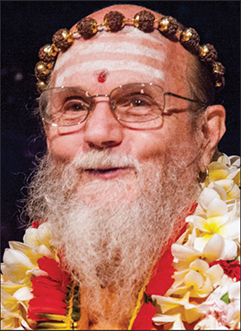PUBLISHER’S DESK • JULY 2015§
The Art of Listening
______________________§
With the modern distraction of digital media, we must be more mindful than ever of person-to-person communications§
______________________§
BY SATGURU BODHINATHA VEYLANSWAMI§
 SOUND IS REGARDED AS DIVINE IN HINDUISM, so it is fitting that listening has always held a central role in the faith. Our core scriptures, the Vedas and Agamas, are referred to as shruti, which means “that which is heard,” as they were originally heard by rishis as an aural transmission directly from God. In the early days of human civilization, prior even to writing, shruti was faithfully preserved without alteration (important because this is the word of God) by means of aural instruction from guru to shishya. This went on generation after generation for thousands of years. Considering the vast body of texts, it is remarkable that this was achieved, and more remarkable still when you know it was accomplished by requiring students to learn each verse in eleven different ways, including backwards.§
SOUND IS REGARDED AS DIVINE IN HINDUISM, so it is fitting that listening has always held a central role in the faith. Our core scriptures, the Vedas and Agamas, are referred to as shruti, which means “that which is heard,” as they were originally heard by rishis as an aural transmission directly from God. In the early days of human civilization, prior even to writing, shruti was faithfully preserved without alteration (important because this is the word of God) by means of aural instruction from guru to shishya. This went on generation after generation for thousands of years. Considering the vast body of texts, it is remarkable that this was achieved, and more remarkable still when you know it was accomplished by requiring students to learn each verse in eleven different ways, including backwards.§
Fortunately, this traditional way of learning the Vedas and Agamas by listening is still practiced in today’s priest training schools. In a typical learning session, the teacher chants a verse once, then the students as a group recite it twice, striving to be faithful to the subtleties of pronunciation and rhythm they hear in the teacher’s chanting. This is not a now-and-again thing. The recitations go on for long hours every day, and every day for years and years. Students begin young, as early as five, when memory is strong.§
Anyone who has seen a great documentary knows how powerful the human voice is as an instrument for communication and sharing of knowledge, so much more effective than reading. Consider pravachan, the popular lectures given by teachers who have personally experienced the truths they are explaining. In these dynamic discourses, the teacher presents the essentials of the Vedas, Upanishads and other scriptures, and those who listen absorb those deep teachings with all of their senses from one who knows. In this sharing, this speaking and hearing, subtle knowledge is transmitted from knower to seeker in a way that cannot be matched by reading. Multiple levels of information are conveyed through such speech—inflection, emotion, emphasis, conviction and subtle intimations.§
My Gurudeva, Sivaya Subramuniyaswami, wrote on this idea: “Because sound is the first creation, knowledge is transferred through sound of all kinds. It is important that one listen to the highest truths of a sampradaya from one who has realized them. The words, of course, will be familiar. They have been read by the devotee literally hundreds of times, but to hear them from the mouth of the enlightened rishi is to absorb his unspoken realization, as he re-realizes his realization while he reads them and speaks them out.”§
I like to think of listening as an art. The idea is that to fully grasp the subject being presented requires attentiveness to the speaker and concentration on the meaning of what is being said. For a mystically profound subject, intuition is also needed to deeply understand what the speaker means, a meaning that lies beyond his words. When attentiveness, concentration and intuition are all present, listening becomes an art. §
This is as true today as it was 2,200 years ago when a village weaver wrote the ethical masterpiece Tirukural. He devotes a full chapter, ten couplets, to “Learning by Listening.” Here are three of Tiruvalluvar’s verses:
“In Heaven, Deities feed from sacrificial fires. On Earth, men who feast on listening are their equal.” “The most precious wealth is the wealth acquired by the ear. Indeed, of all wealth, that wealth is paramount.” “If not pierced by acute listening, ears may hear and
yet remain deaf.Ӥ
As we all know, the art of listening faces a new challenge in our modern age: digital distraction. Computers and mobile phones, and the constant stream of stimuli they offer, profoundly challenge everyone’s ability to focus, listen and learn. A New York Times article entitled “Growing up Digital, Wired for Distraction” addressed the issue: §
“Researchers say the lure of these technologies, while it affects adults too, is particularly powerful for young people. The risk, they say, is that developing brains can become more easily habituated than adult brains to constantly switching tasks—becoming less able to sustain attention. ‘Their brains are rewarded not for staying on task but for jumping to the next thing,’ said Michael Rich, an associate professor at Harvard Medical School and executive director of the Center on Media and Child Health in Boston. And the effects could linger: ‘The worry is we’re raising a generation of kids in front of screens whose brains are going to be wired differently.’”§
That was written in 2010. Since then the number of smartphone users in the US alone has tripled. In any public place, it seems everyone is carrying a phone and accessing it often. It could be called device addiction. §
The Times article goes on to say that researchers have found that students’ use of technology is not uniform. Their choices tend to reflect their personalities. Social butterflies tend to be heavy texters and Facebook, Twitter or Instagram users. Students who are less social may escape into games, while drifters or those prone to procrastination might surf the Web or watch videos.§
The Hindu home is crucially impacted by digital distraction. Important Hindu teachings, its principles, stories and ethics, are traditionally conveyed to young children by their grandparents. Parents communicate what is needed for their teenage children to understand the new duties they are maturing into. Parents also regularly share information about current happenings in the family and future plans. All this person-to-person communication is impeded when family members turn constantly to their digital world and stop having meaningful conversations with one another. A common sight these days is a family sitting together with each member fixated on his or her phone or tablet, with no talking or listening taking place. Though they share the same room, their minds are elsewhere.§
It would be unwise to allow digital information to overwhelm us even more than life’s modern conveniences already have. The Amish, a small religious community in the US, have taken an extreme stand against modernism, living as people did two centuries ago in an effort to preserve their culture and perpetuate their religion. One documentary tells the story of an Amish family that eliminated all possibilities for modern distractions, including digital, by having no electricity in the home. For most of us that would be too radical. A more balanced solution for Hindu families is to establish set times for digital study and enjoyment and other times for healthy in-person communication with family members and friends (with digital devices turned off).§
Recently a young Hindu couple proudly told me that digital devices are banned from the dinner table in their home, a simple rule that is enriching their interactions and strengthening their relationships. A number of families have reined in digital distractions by requiring that their children’s computers remain in the living room, where family members can provide oversight. Others have found tools to restrain where their children can go online. §
For his devotees, Gurudeva designated Monday as Family Home Evening, a time for sharing among family members. “On Monday evening, Siva’s day, the family members get together, prepare a wonderful meal, play games together and verbally appreciate one another’s good qualities. They don’t solve any problems on that day. They just love each other, and everybody has a voice, from the littlest child to the oldest senior.” The television and all digital devices are turned off. It’s a time for listening, real listening. Being a good listener can lead to being a good conversationalist—another fine art jeopardized by digital distraction.§
I developed a simple sadhana called Supportive Conversation to strengthen bonds with a family member or friend. Here it is.§
1. Stop what you are doing when approached, smile, face the person, extend a kind greeting and give him or her your full attention. Put down or turn off your mobile device.§
2. Listen carefully. Do not interrupt. Concentrate on what is being said. If it is troublesome to you, remember the adage, “Seek to understand before seeking to be understood.” Get engaged and show support by responding sincerely and constructively.§
3. Ask for elaboration, especially if the person is sharing an emotional experience. Be patient, listen with all of your senses. If you feel it is taking too long, affirm mentally that you have all the time in the world.§
4. Practice empathy; put yourself in the other person’s place. If you were speaking, you would want others to fully listen. Remember, you don’t have to provide solutions, just a caring ear. Your hearing the story is enough.§
Perhaps the art of listening will enjoy a comeback with the help of digital media, as the word spreads virally on what we miss without it. Listening is how we most naturally learn. It is a skill that needs to be perpetuated, even honed, from generation to generation. Parents need to carefully guide their children’s development, to avoid digital distraction, develop the listening art and hopefully, if all goes well, awaken intuition and compassion for others. Adults need to make sure they themselves are not indulging excessively in a digital world. This will insure that the knowledge and practices of Hinduism continue to thrive in this digital era.§
PUBLISHER’S DESK • OCTOBER 2008§
Using TV as a Spiritual Tool
______________________§
Television, like real life, can help us work through our karma, if we approach it in the right way§
______________________§
BY SATGURU BODHINATHA VEYLANSWAMI§
 TELEVISION IS A LITTLE LIKE GOD: it’s everywhere. Traveling by plane and staying in hotels, you encounter TV at dawn in the hotel’s fitness center, then in the breakfast cafe and later at the airport and even on the plane 30,000 feet above the Earth! Settling down that night in your next hotel three thousand miles away, the TV is there; and sometimes it has already been turned on for you! Talk about ubiquitous influences.§
TELEVISION IS A LITTLE LIKE GOD: it’s everywhere. Traveling by plane and staying in hotels, you encounter TV at dawn in the hotel’s fitness center, then in the breakfast cafe and later at the airport and even on the plane 30,000 feet above the Earth! Settling down that night in your next hotel three thousand miles away, the TV is there; and sometimes it has already been turned on for you! Talk about ubiquitous influences.§
A well-researched web article notes that close to 100 percent of the adult population watch some television every day in the media-saturated societies of North America, Western Europe, East Asia and in most Latin American countries. In the rest of the world—with the exception of some African countries and India, where the percentages are 56 percent and 64 percent, respectively—TV is the daily fare of 70 to 85 percent of the adult population.§
The best TV shows are viewed all over the world. When my guru, Sivaya Subramuniyaswami, visited South Africa in the 1990s, he was advised not to hold events on Wednesday nights because the popular American soap opera “Dallas” was on that night, and everyone would stay home to watch it. When populations around the globe view the same material on television, it unifies the thinking, for better or worse, and thus the actions, of Earth’s peoples. Gurudeva observed, “Today, television has become an instrument to convey knowledge and bring the world together, set new standards of living, language, styles of dress and hair, ways of walking, ways of standing, attitudes about people, ethics, morality, political systems, religions and all sorts of other things, from ecology to pornography.”§
Television, like the fashion world, has its own trends over the decades. There was a time, back in the 60s, when nearly every show was about cowboys and Indians, set in America’s Wild, Wild West. Then came the era of quiz shows, like the “$64,000 Question” and “Truth or Consequences.” Around the same time, there was a wave of Carol Burnett- and Ed Sullivan-type talent shows. Later, TV featured evening dramas: “Dynasty,” “Falcon Crest” and a galaxy of others. More recently, humanity has been inundated with stories about detectives, crime scene investigators, lawyers, reality shows and dirty, rotten scoundrels. §
Lately, we have a new breed of fiction and nonfiction programming with mystical themes: prescient dreams, immortality and reincarnation, humans with remarkable powers such as reading minds, seeing and speaking to the dead, stopping time, listening to people’s thoughts and flying through space and time. It’s a fascinating evolution to follow, and I find it encouraging that viewers are interested in these mystical ideas and themes, interested in the untapped potential of the human mind. §
How does significant exposure to television affect us? Is it making us wiser or worldlier? Is it a help or a hindrance to our spiritual progress? The key lies in how we approach it and what we watch. Approached in the right way, TV can be a tool for spiritual progress.§
To elucidate this point, let’s compare TV to the world. Our paramaguru, Siva Yogaswami, noted: “The world is an ashram, a training ground for the achievement of moksha [liberation].” Of course, for that to be true for you, you have to make it that way; you have to hold that perspective. What is the world to a carefree, fun-loving high schooler? It’s a place to party, kick back and hang out. To an up-and-coming entrepreneur, the world holds the promise of lots of money. That’s his focus. Others are focused on fulfilling a profession or perfecting an art. To some, it’s all about relationships, making friends, building a family. In short, the world is what we make it. It’s not something unto itself that we all look at the same way.§
To the practicing, mystically awakened Hindu, the world is fundamentally a place to make spiritual progress, where we face our karma and grow from experience. Karma normally comes to us through individuals or groups of people. It is not always pleasant. Situations don’t always work out fairly. Sometimes we are mistreated. Philosophically, we know that this is the result of our prarabdha karmas. How we face such situations is crucial. The instinctive response is to retaliate: “This person is mistreating me, so I’m going to mistreat him in the same way.” But if we do retaliate, we create new negative karma which will return to us as painful experiences in the future. That is not spiritual progress.§
As I explained in our “Karma Management” Insight (Oct/Nov/Dec, 2002), the goal is 1) to not retaliate; 2) instead, accept the karma that comes to us as our own creation; and 3) ideally, forgive and forget the whole event, rather than holding onto it and letting it gnaw at us on the inside. When we successfully handle a karma according to these three principles, we make spiritual progress. We are looking at the world as an ashram.§
Gurudeva explained this beautifully: “Hindus know that the object of life is to go through our experiences joyously and kindly, always forgiving and compassionately understanding, thus avoiding making unseemly kriyamana karmas in the current life which, if enough were accumulated and added to the karmas we did not bring into this life, would bring us back into another birth, and the process would start all over again.”§
Like living in the world in the right spirit, viewing television from the correct perspective can help us face and manage our karma. As Gurudeva noted, “Television has afforded us the ability to work through our karmas more quickly than we could in the agricultural age. On TV, the ‘other people’ who play our past experiences back to us, for us to understand in hindsight, are actors and actresses, newscasters and the people in the news they broadcast. Hindus know nothing can happen, physically, mentally or emotionally, but that it is seeded in our prarabdha karmas, the action-reaction patterns brought with us to this birth. Therefore, on the positive side, we look at television as a tool for karmic cleansing. The great boon that television has given humanity, which is especially appreciated by Hindus, is that we can soften our prarabdha karmas quickly by analyzing, forgiving and compassionately understanding the happenings on the screen, as our past is portrayed before us, and as we work with our nerve system, which laughs and cries, resents, reacts to and avoids experiences on the TV.”§
That is a powerful idea: that television is a tool for karmic cleansing. It’s all in our approach, our attitude, toward it. Specifically, television helps soften our karmas. The karma still comes to us, but we have prepared ourself to receive it by watching similar situations on television and gaining an understanding the nature of that kind of action and reaction. We have “pre-lived” it through the actors and actresses. Thus, when the karma comes, we don’t react as strongly, or it comes to us in a less disruptive way. We handle it with less emotion and more wisdom, less reaction and more understanding.§
Parents can help their children learn to use television to increase spirituality by watching programs together and discussing them afterwards. Talk about the various characters, their actions and the consequences of those actions. A good perspective to convey is that “All men are your teachers. Some teach you what to do, and others teach you what not to do.” Oftentimes on today’s television programs the principles of reincarnation and karma are presented in one form or another. This can be pointed out and discussed to see how accurately the concept was presented. There’s even a popular comedy about karma, called “My Name Is Earl,” which tells of a man working hilariously to resolve his past misdeeds. Mystical practices, which are common in recent shows, such as being able to read other’s thoughts or seeing the future in a dream, are also useful to talk about with children, drawing out lessons to be learned.§
Before the widespread viewing of television, storytelling was a common form of entertainment. Gurudeva describes this shift: “Television at its best is storytelling. We used to sit around and tell stories. The best storyteller, who could paint pictures in people’s minds, was the most popular person in town. In every country, at every point in time, humans have sat down and been entertained, and entertainers have stood up and entertained them.”§
The advantage of storytelling is that the teller or reader of the story can choose tales with strong dharmic themes and avoid those with adharmic ones. With television, while you do have the choice of what shows to watch, the themes and plots are in the hands of the writers and producers, who come from all sorts of backgrounds. So, it can take some creativity on your part to find ways to view television—personally and with your children—so that it strengthens you spiritually, makes you wiser rather than worldlier.§
Definitely, we don’t want to watch TV too much. Gurudeva’s advice is: “Siva’s devotees may watch television and other media for recreation and to keep informed about the world, limiting viewing to about two hours a day. They avoid nudity, foul language, crudeness and excessive violence.… Television can be very entertaining and helpful, or it can be insidiously detrimental, depending on how it is used. Therefore, fortify your mind with a thorough understanding of what you are watching.”§
PUBLISHER’S DESK • JULY 2007§
Planning: the Key to Success
______________________§
When problems arise, rather than restructuring your buildings, look to your business and family planning§
______________________§
BY SATGURU BODHINATHA VEYLANSWAMI§
 A NEW TREND IN HINDU COMMUNITIES around the world is the widespread, one could even say faddish, application of the principles of the ancient Hindu science of vastu to the design of businesses and homes. Vastu has always been used in the construction of Hindu temples and in village home design. In theory, the widened use of vastu in the Hindu community and beyond is a positive development.§
A NEW TREND IN HINDU COMMUNITIES around the world is the widespread, one could even say faddish, application of the principles of the ancient Hindu science of vastu to the design of businesses and homes. Vastu has always been used in the construction of Hindu temples and in village home design. In theory, the widened use of vastu in the Hindu community and beyond is a positive development.§
Vastu unfolds the scientific principles and models of spiritual art and architecture to yield a harmonious flow of energy in the physical environment, giving rise to good health, wealth, intelligence, happiness and attunement with the wider universe.§
Renowned Indian architect and Vastu Shastra expert Dr. V. Ganapati Sthapati explains: “In literal terms, vastu means ‘to dwell’ or ‘to exist’ and shastra means science. The main aim of vastu science is to create building spaces to live in harmony with subtle nature.”§
Following vastu principles of design can certainly make businesses more successful and homes more harmonious. However, the problematic trend is to emphasize it above all else—thinking that the sole cause of obstacles and lack of success is the flawed layout of one’s home or office. For example, the sales of a business drop precipitously, and a vastu expert is consulted. He asserts that the cause is the poor layout of the space and advises: “Rebuild the structure according to my vastu design and your problems will quickly disappear!”§
We know of many Hindus who received such advice over the last few years, some who inadvisedly spent large sums of money taking down and rebuilding parts of their home or office—or moving to a new location—in anticipation that this would solve all their problems. The truth is that in most cases it did not.§
Designing one’s home and business spaces according to vastu principles is an excellent goal. When asked, we encourage Hindus to have their new home or business designed in this way. The traditional, all-granite hand-carved Iraivan Temple we are building here in Hawaii follows the guidelines of vastu as interpreted by Dr. V. Ganapati Sthapati, whom we quoted above. Regarding vastu remodeling, he observes, “Modifications of a building lead to a disturbance of energy inside the enclosed space. Hence the shastras do not recommend any post-construction alterations.… As our modern age has created a lifestyle crisis, many architects and designers are now turning to the ancient traditions of vastu for inspiration. Sadly, this has led to a lot of exploitation and misinterpretation.”§
Common sense tells us that there are many causes for not being successful. In my experience, the most common one is lack of proper planning. In the words of French author and aviator Antoine de Saint-Exupéry, “A goal without a plan is just a wish.”§
Planning in Business§
Let me share a story. A young couple who had pilgrimaged to our Kauai monastery told me of their ambition to give up their current employment and open an ice cream shop in Florida. I encouraged them to develop a solid business plan before starting and suggested working with their local Small Business Administration (SBA), a government agency that gives sound advice to small businesses for free. They opened the shop soon after but never took the time to develop a business plan. A few months later they e-mailed me lamenting that the new business was not doing well. Little wonder, I thought.§
My guru strongly counseled devotees on the importance of planning. He wrote a sutra expressing the relationship of planning to success: “Siva’s devotees approach each enterprise with deliberate thoughtfulness, and act only after careful consideration. They succeed in every undertaking by having a clear purpose, a wise plan, persistence and push.”§
The quality and comprehensiveness of our plan is a major factor in our ultimate success. Thus it is wise to draw on all the planning resources available to us. There are many good books and software programs on business planning. However, it is essential to also seek out first-hand advice from experts in the field. Ask them key questions about the opportunities and challenges. In large ventures, it is advisable to hire a professional consultant. Creating a plan when starting a business is crucial. That plan must then be updated every few years to keep up with our rapidly changing world.§
Once your plan is complete, inaugurate it through prayer. Go to the temple on an auspicious day and worship Lord Ganesha through attending puja, having an archana or a special abhishekam or homa beseeching His blessings for a grand success.§

S. RAJAM§
Don’t blame the building: This businessman is being warned that recent downturns in his company can be traced to the inauspicious engineering of his office, there in the background, which should be rebuilt to assure success. He explains his own solution, exhibiting his detailed business plan for a better future.§
Personal and Family Planning§
Of course, the benefits of planning are not limited to the business or financial side of life. Personal life can also benefit, for a plan keeps us focused and motivated toward specific goals in life’s various departments. Though the connection may not be immediately apparent, having an up-to-date personal plan is quite helpful for our spiritual advancement, as it helps us maintain a balanced approach to living.§
To help you create a business plan, there are scores of resources available. You can find web listings of specialized software for business plans. Search engines give you hundreds to choose from. But if you google “Personal Plan Software” or “Family Plan Software,” how many do you find? Zero. A search for books to buy on the subject? Again: countless titles on business planning but none on personal planning.§
It is clear we have to create our own approach in this area. We can, however, draw a few important points from business plan resources. They all start by listing the objectives, then outlining the strategy to accomplish them, including financial considerations.§
A business develops goals for its various departments, such as production, sales, marketing and finance. For our personal plan, it is useful to divide life into its major departments. My guru designated a fivefold division that encompasses all aspects of life—spiritual, social, cultural, economic and educational—to which we have added a sixth: physiological.§
Our first step is to list our goals or objectives in each of the six areas. Ask six questions and write down the answers to each. What are the family’s (or individual’s): 1) spiritual goals? 2) social goals? 3) cultural goals? 4) economic goals? 5) educational goals? 6) physical and health goals?§
As you begin this process, the question will sooner or later arise of how many years ahead to plan: one, two, three, six, ten? Gurudeva recommended a six-year time frame as ideal, then each year adding one more year to the plan to keep it always six years into the future. However, if six years seems a bit daunting at first, a good minimum period to start with is three years. Here are some sample goals in each area.§
Spiritual: Yearly pilgrimage to a temple or holy place, even if it’s just a few hundred miles away. For example, Singapore devotees enjoy group pilgrimages to temples in neighboring Malaysia.§
Social: Extended-family gatherings. Special family outings. When is the last time your family went horseback riding?§
Cultural: Children taking dance and music lessons. Attending cultural performances as a family. Adults taking time to paint, play music and sing.§
Economic: Saving for the children’s education. Saving for retirement.§
Educational: Children’s secular education. Adults acquiring new skills. Training to advance career. Learning about herbs, healing, making preserves; arts and crafts.§
Physiological: All health goals, diets, pancha karma and other therapies and fasting regimens, exercise and care of one’s physical environment, including clothing and hobbies, can be included in this category.§
As with a business plan, it is necessary to revise your personal plan periodically to adjust to major changes in circumstances, such as moving to a new community, job change, retirement, caring for an elderly parent, children leaving home when they marry or go off to college, large inheritances, and severe illness or accident.§
When challenges arise, it is important to act swiftly, tactically and responsibly to find the cause and apply the proper remedy. Don’t listen to those who would solve your problems, and build their own business, by rebuilding or rearranging your house or offices. It’s not, in my experience, an effective solution. Work instead on your plan. Who knows, you may become so successful that, as your plan manifests your aspirations, five years from now you can put up a new building designed according to the venerable wisdom of vastu!§





